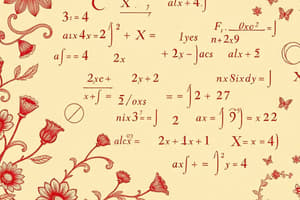Podcast
Questions and Answers
What is the primary goal when solving a linear equation?
What is the primary goal when solving a linear equation?
- To factor the equation.
- To isolate the variable. (correct)
- To find the constant value.
- To eliminate all variables.
Which of the following represents a polynomial?
Which of the following represents a polynomial?
- √x + 1
- 4x^2 - 3x + 7 (correct)
- 2x + 5
- x/(x - 1)
In the expression $a^m ÷ a^n$, what is the simplified form based on the quotient of powers rule?
In the expression $a^m ÷ a^n$, what is the simplified form based on the quotient of powers rule?
- $a^{m*n}$
- $a^{m-n}$ (correct)
- $a^{m+n}$
- $a^{mn}$
What does the notation f(x) typically denote?
What does the notation f(x) typically denote?
When solving inequalities, what must you remember to do when multiplying both sides by a negative number?
When solving inequalities, what must you remember to do when multiplying both sides by a negative number?
What is the first step in solving a linear equation?
What is the first step in solving a linear equation?
What is the greatest common factor (GCF) used for in factoring?
What is the greatest common factor (GCF) used for in factoring?
Which method can be used to solve systems of equations?
Which method can be used to solve systems of equations?
Flashcards
Variable
Variable
A symbol (often a letter) that represents an unknown number.
Linear Equation
Linear Equation
An equation in the form ax + b = c, where a, b, and c are numbers.
Order of Operations
Order of Operations
Rules for evaluating expressions (PEMDAS/BODMAS).
Function
Function
Signup and view all the flashcards
Exponent Rule: Product of Powers
Exponent Rule: Product of Powers
Signup and view all the flashcards
Solving Equations
Solving Equations
Signup and view all the flashcards
Factoring
Factoring
Signup and view all the flashcards
Inequality
Inequality
Signup and view all the flashcards
Study Notes
Basics of Algebra 1
- Variables: Symbols (often letters) that represent numbers (e.g., x, y).
- Constants: Fixed values (e.g., 5, -3).
- Expressions: Combinations of variables, constants, and operations (e.g., 3x + 2).
Operations
- Addition (+), Subtraction (−), Multiplication (×), Division (÷).
- Order of Operations: PEMDAS (Parentheses, Exponents, Multiplication and Division (left to right), Addition and Subtraction (left to right)).
Solving Equations
- Linear Equations: Form ax + b = c.
- Goal: Isolate the variable (x).
- Steps:
- Simplify both sides.
- Use inverse operations to isolate the variable.
- Check the solution by substituting back.
Inequalities
- Types: <, >, ≤, ≥
- Solving: Similar to equations; reverse the inequality sign when multiplying or dividing by a negative number.
Functions
- Definition: A relation where each input has exactly one output.
- Notation: f(x) denotes a function f with x as the input.
- Graphing: Plotting points (x, f(x)) on a coordinate plane.
Systems of Equations
- Methods to Solve:
- Graphing: Plot both equations to find the intersection point.
- Substitution: Solve one equation for a variable and substitute into the other.
- Elimination: Add or subtract equations to eliminate a variable.
Polynomials
- Definition: An expression with terms consisting of variables raised to whole-number powers (e.g., 4x^2 - 3x + 7).
- Operations: Addition, subtraction, multiplication, division (with long division or synthetic division).
Factoring
- Methods:
- Factoring out the greatest common factor (GCF).
- Factoring trinomials (e.g., x^2 + bx + c).
- Difference of squares: a^2 - b^2 = (a - b)(a + b).
Exponents
- Rules:
- Product of Powers: a^m × a^n = a^(m+n)
- Quotient of Powers: a^m ÷ a^n = a^(m-n)
- Power of a Power: (a^m)^n = a^(m*n)
Radicals
- Definition: Expressions containing roots (e.g., √x).
- Operations: Simplifying roots, adding/subtracting like terms.
Applications
- Word Problems: Translate verbal descriptions into algebraic expressions or equations.
- Real-world Applications: Use algebra to solve problems related to finance, physics, and engineering.
Key Concepts to Remember
- Always check your solutions.
- Practice simplifying complex expressions.
- Understand the properties of equality and inequality.
- Familiarize yourself with function notation and graphing techniques.
Basics of Algebra 1
- Variables represent unknown values, denoted by letters like "x" and "y".
- Constants are fixed numbers, like 5 or -3.
- Expressions combine constants, variables, and mathematical operations like 3x + 2.
Operations
- Addition (+), Subtraction (−), Multiplication (×), and Division (÷) are fundamental operations.
- Order of Operations, using the acronym PEMDAS, ensures calculations are done in the correct sequence - parentheses, exponents, multiplication and division (from left to right), then addition and subtraction (from left to right).
Solving Equations
- Linear equations are written in the form ax + b = c, where a, b, and c are constants.
- The goal is to isolate the variable (x), meaning to get it by itself on one side of the equation.
- Steps involve simplifying both sides of the equation using inverse operations (addition/subtraction, multiplication/division).
Inequalities
- Inequalities use symbols like < (less than), > (greater than), ≤ (less than or equal to), and ≥ (greater than or equal to).
- Solving inequalities is similar to solving equations, but remember to reverse the inequality sign if multiplying or dividing by a negative number.
Functions
- Functions are relationships where each input (x) has only one output (f(x)).
- f(x) notation represents a function f with an input of x.
- Graphing functions involves plotting points (x, f(x)) on a coordinate plane.
Systems of Equations
- Solving Systems of Equations involves finding the point where two or more equations intersect.
- Methods include graphing, substituting, and elimination.
Polynomials
- Polynomials are expressions with terms where variables are raised to whole-number powers (e.g., 4x^2 - 3x + 7).
- Operations on polynomials include addition, subtraction, multiplication, and division (using long division or synthetic division).
Factoring
- Factoring breaks down complex expressions into simpler ones.
- Common methods include factoring out the greatest common factor, factoring trinomials, and using the difference of squares formula: a^2 - b^2 = (a - b)(a + b).
Exponents
- Exponents indicate the power or how many times a base is multiplied by itself.
- Rules of exponents simplify calculations, including:
- Product of Powers: a^m × a^n = a^(m+n)
- Quotient of Powers: a^m ÷ a^n = a^(m-n)
- Power of a Power: (a^m)^n = a^(m*n)
Radicals
- Radicals are expressions containing roots (e.g., √x).
- Operations on radicals include simplifying roots and adding or subtracting like terms.
Applications
- Word Problems involve translating real-world scenarios into algebraic expressions or equations.
- Real-world applications of algebra are found in finance, physics, and engineering to solve problems and make predictions.
Key Concepts to Remember
- Check solutions to ensure accuracy.
- Practice simplifying complex expressions to gain proficiency.
- Understand the properties of equality and inequality to solve equations and inequalities correctly.
- Familiarity with function notation and graphing techniques is crucial for understanding and solving various problems.
Studying That Suits You
Use AI to generate personalized quizzes and flashcards to suit your learning preferences.




